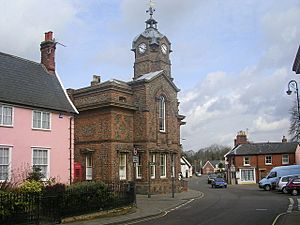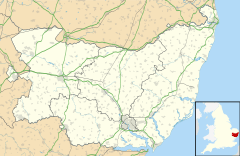Eye, Suffolk facts for kids
Quick facts for kids Eye |
|
|---|---|
 Eye Town Hall |
|
| Population | 2,210 (2021) |
| OS grid reference | TM144739 |
| Civil parish |
|
| District | |
| Shire county | |
| Region | |
| Country | England |
| Sovereign state | United Kingdom |
| Post town | EYE |
| Postcode district | IP23 |
| Dialling code | 01379 |
| Police | Suffolk |
| Fire | Suffolk |
| Ambulance | East of England |
| EU Parliament | East of England |
| UK Parliament |
|
Eye (pronounced like the letter "I") is a small market town and civil parish in the Mid Suffolk district. It's located in the north of the English county of Suffolk. The town is about 4 miles (6.4 km) south of Diss, 17.5 miles (28 km) north of Ipswich, and 23 miles (37 km) south-west of Norwich.
In 2021, the population of Eye was about 2,210 people. The town is close to the River Waveney, which marks the border with Norfolk. It also sits on the River Dove. Eye is a twin town with Pouzauges in France.
Contents
What's in a Name? The Meaning of "Eye"
The town's name, Eye, comes from an Old English word. This word means "island" or "land by water." It's believed that the first settlement here was almost completely surrounded by water. This water came from the River Dove and its smaller streams. Even today, areas near the river can sometimes flood.
Eye's Past: A Look at Its History
People have lived in and around Eye for a very long time. Tools and items from the Stone Age and Bronze Age have been found here. The earliest signs of a settlement date back to the Roman period. These include old buildings and coins from around 365 CE.
Ancient Discoveries: Roman Coins and Anglo-Saxons
In 1818, a large Anglo-Saxon cemetery was found near Waterloo Plantation. It contained many urns with ashes and some burials from the 6th century. In 1781, workers found a lead box by the river at Clint Farm. This box held about 600 Roman gold coins. These coins were from the reigns of several Roman emperors, dating from 364 to 423 CE.
Norman Conquest and Eye Castle
Before the Norman Conquest in 1066, Eye was owned by Edric of Laxfield. He was a rich and powerful Saxon landowner. After the Normans took over England, Eye became very important. The Honour of Eye was given to William Malet, a Norman lord.
Between 1066 and 1071, William Malet built Eye Castle as his military base. He also started a market, which helped Eye grow into a town. In 1086–1087, William's son, Robert Malet, founded Eye Priory.
Eye began to lose its importance after 1173. This was when the castle was attacked during a rebellion against King Henry II. It was also attacked during the Second Barons' War in 1265. After these attacks, the castle never fully recovered its former status. The castle's prison was used until the early 1600s. Most of the castle buildings were taken down in the 1300s. A windmill stood on the castle mound from 1561 until 1844. Then, a round, fake castle tower was built there.
Eye's Borough Status and Political Changes
Eye was once known as the smallest borough in the country. This claim was based on a charter from King John in 1205. A charter is a special document that grants rights. This charter was renewed many times by different monarchs.
However, in 1885, it was discovered that the original charter actually belonged to Hythe in Kent. This mistake happened because the old English names of the towns were very similar. Even though the error was confirmed in the 1950s, Eye kept its borough status until 1974. In 1974, Eye became part of the Mid Suffolk district. Eye still has a Town Council and a Mayor today.
From 1571 to 1832, Eye had two Members of Parliament (MPs). After the Reform Act 1832, it had one MP until 1983.
Local Families and Industry
The important Cornwallis family lived nearby at Brome Hall from the 1300s. Members of this family, like Charles Cornwallis, 1st Marquess Cornwallis, represented Suffolk in the House of Commons.
The Lordship of the Manor of Eye is currently held by the Palmer family of Haughley. This manor was once held by many famous people, including King Stephen and Thomas Beckett. It included 129 smaller manors.
The earliest records of industry in Eye mention that in 1673, women made "bone lace". By 1830, lace-making was still a common job for women. Eye was a center for lace-making for many years.
The Railway and World War II
In 1846, Eye Borough Council tried to get the new London-Norwich railway line to pass through Eye. But the line, finished in 1849, went through Diss instead. This helped Diss grow, while Eye's importance decreased. Eye railway station, which was on a branch line from Mellis, closed to passengers in 1931 and to freight in 1964.
Eye Airfield, located north-east of the town, was once RAF Eye. During the Second World War, it was used by the USAAF's 490th Bomb Group.
Modern Eye: Services and Amenities
Today, Eye has a population of just over 2,000 people. Hartismere School provides secondary education, and St Peter and St Paul CE Primary School offers primary education. The town also has a health center, a library, a police station, and a fire station. A community hospital opened in 2012.
The town's Guildhall is a very old and important building, now a private home. Eye Town Hall is a unique and interesting building from 1856. It was designed by Edward Buckton Lamb.
Church of St Peter and St Paul: A Local Landmark
The Church of St Peter and St Paul is a Grade 1 listed building from the 14th century. It is considered one of the most beautiful churches in the county. A doorway from an even older 13th-century building was kept when the church was rebuilt.
New work and renovations were done in the 15th and 16th centuries. This included adding special tombs for William Honnyng and Nicholas Cutler. The church was restored in 1868. A very special feature is a late 15th-century rood screen. This screen has a loft and a rood (a crucifix) designed by Ninian Comper in 1925. The church tower is 107 feet (33 meters) high to the top of its pinnacles.
Famous Faces: Notable People from Eye
Many interesting people have connections to Eye:
- Spencer Compton, 1st Earl of Wilmington (1674–1743) was an MP for Eye. He became Speaker of the House of Commons and later the second Prime Minister of Great Britain.
- Rear-Admiral Sir Charles Cunningham (1755–1834) was a naval officer. He fought in the American War of Independence and the French Revolutionary and Napoleonic Wars.
- Sir Edward Kerrison (1776–1853) was also an MP for Eye and a British army officer. He fought in the Battle of Waterloo.
- Concordia Merrel (1886–1962), an actor and writer, lived and died in Eye.
- Sir Frederick Ashton (1904–1988) was a famous ballet dancer and choreographer with The Royal Ballet. He lived in Eye and is buried nearby.
- Cavendish Morton (1911–2015) was an artist who lived in Eye. He was an art therapist at Hartismere Hospital and served as Town Mayor twice.
- Janet Frame (1924–2004), a New Zealand author, rented a cottage near Eye in 1963–1964. She started a novel set in the area, calling Eye "Murston" in her book.
- Helen Fraser (born 1942), an actress, lives in Eye.
- Brian Capron (born 1947), an actor, was born in Eye.
- Matthew Upson (born 1979), a professional footballer, was born in Eye.
- Stuart O'Keefe (born 1991), a professional footballer, was born in Eye.
See also
 In Spanish: Eye (Suffolk) para niños
In Spanish: Eye (Suffolk) para niños




